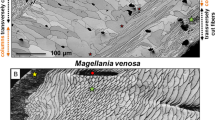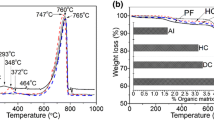Abstract
The mollusk shell mobilizes calcium from environment for skeletal mineralization. This occurs through synthesizing solids in solution in the presence of organic molecules of specific interior regions of the conch shell. The ultrastructure and micro-hardness of the Hemifusus tuba conch shell living in the Huang/Bo sea area are investigated in the paper. It is shown that the composition and microstructure of the mollusk shell vary in different positions. The prodissoconch shell consists only of aragonite with the crossed-lamellar microstructure. While the spiral shell and the body shell of the Hemifusus tuba conch shell are composed of one calcite layer and several aragonite layers. The calcite layer consists of cylindrical grains, but the aragonite layers are crossed-lamellar ultrastructure at three size scales. The minimum structure size (the third-order lamella) is at about 20 nm - 80 nm. The margin of shell aperture is only composed of calcite with cylindrical grains. This natural optimization of the shell microstructure is intimately due to the growth of the organic matrix. At different positions the microhardness of mollusc shell is different due to different crystal structures and crystal arrangements. The growth process of shells allows a constant renewal of the material, thus enabling their functional adaptation to external environments.
Similar content being viewed by others
References
Rubner M. Synthetic sea shell. Nature, 2003, 423, 925–926.
Heuer A H, Fink D J, Laraia V J, Arias J L, Calvert P D, Kendall K, Messing G L, Blackwell J, Rieke P C, Thompson D H, Wheeler A P, Veis A, Caplan A I. Innovative materials processing strategies: A biomimetic approach. Science, 1992, 255, 1098–1105.
Berman A, Addadi L, Weiner S. Interactions of seaurchin skeleton macromolecules with growing calcite crystals a study of intracrystalline proteins. Nature, 1988, 331, 546–548.
Aizenberg J, Black A J, Whitesides G M. Control of crystal nucleation by patterned self-assembled monolayers. Nature, 1999, 398, 495–498.
Xu G, Aksay I A, Groves J T. Continuous crystalline carbonate apatite thin films. A biomimetic approach. Journal of the American Chemical Society, 2001, 123, 2196–2203.
Almqvist N, Thomson N H, Smith B L, Stucky G D, Morse D E, Hansma P K. Methods for fabricating and characterizing a new generation of biomimetic materials. Materials Science and Engineering: C, 1999, 7, 37–43.
Zhou B L. Bio-inspired study of structural materials. Materials Science and Engineering: C, 2000, 11, 13–18.
Belcher A M, Hansma P K, Stucky G D, Morse D E. First steps in harnessing the potential of biomineralization as a route to new high-performance composite materials. Acta Materialia, 1998, 46, 733–736.
Westbroek P, Marin F. A marriage of bone and nacre. Nature, 1998, 392, 861–862.
Fritz M, Belcher A M, Radmacher M, Walters D A, Hansma P K, Stucky G D, Morse D E, Mann S. Flat pearls from biofabrication of organized composites on inorganic substrates. Nature, 1994, 371, 49–51.
Addadi L, Weiner S. A pavement of pearl. Nature, 1997, 389, 912–915.
Checa A G, Rodriguez-Navarro A B. Self-organisation of nacre in the shells of Pterioida (Bivalvia: Mollusca). Biomaterials, 2005, 26, 1071–1079.
Geerat J V. A Natural History of Shells, Princeton University Press, USA, 1993.
Kessler H, Spearing L, Heuer A H. Optimization of a structural composite by mimicking the structure of the Strombus gigas conch shell. ASME Advances in Bioengineering, 1994, 25, 39–48.
Kessler H, Ballarini R, Mullen R L, Kuhn L T, Heuer A H. A Biomimetic example of brittle toughening (I) Steady state multiple cracking. Computational materials Science, 1996, 5, 157–166.
Kamat S, Su X, Ballarini R, Heuer A H. Structural basis for the fracture toughness of the shell of the conch Strombus gigas. Nature, 2000, 405, 1036–1040.
Kamat S, Kessler H, Ballarini R. Fracture mechanisms of the Strombus gigas conch shell: II-mciromechanics analyses of multiple cracking and large-scale crack bridging. Acta Materialia, 2004, 52, 2395–2406.
Belcher A M, Wu X H, Christensen R J, Hansma P K, Stucky G D, Morse D E. Control of crystal phase switching and orientation by soluble mollusk-shell proteins. Nature, 1996, 381, 56–58.
Falini G, Albeck S, Weiner S, Addadi L. Control of aragonite or calcite polymorphism by mollusk shell macromolecules. Science, 1996, 271, 67–69.
Liang Y, Zhao J, Wang L, Li F. The relationship between mechanical properties and crossed-lamellar structure of mollusk shells. Materials Science and Engineering: A, 2008, 483-484, 309–312.
Cheong S C, Yong W K. A study of the correlation between organic matrices and nanocomposite materials in oyster shell formation. Biomaterials, 2000, 21, 213–222.
Clarke A. Life in cold water:the physiological ecology of polar marine ecosystedms. Oceanography and Marine Biology Annual Review, 1983, 21, 341–453.
Lowenstam H A. Biominerlization processes and products and the evolution of biomineralization. Palaeontology, 1984, 2, 79–95.
Author information
Authors and Affiliations
Corresponding author
Rights and permissions
About this article
Cite this article
Liang, Y., Zhao, J. & Wu, C. The micro/nanostructure characteristics and the mechanical properties of Hemifusus tuba conch shell. J Bionic Eng 7, 307–313 (2010). https://doi.org/10.1016/S1672-6529(10)60261-2
Published:
Issue Date:
DOI: https://doi.org/10.1016/S1672-6529(10)60261-2




